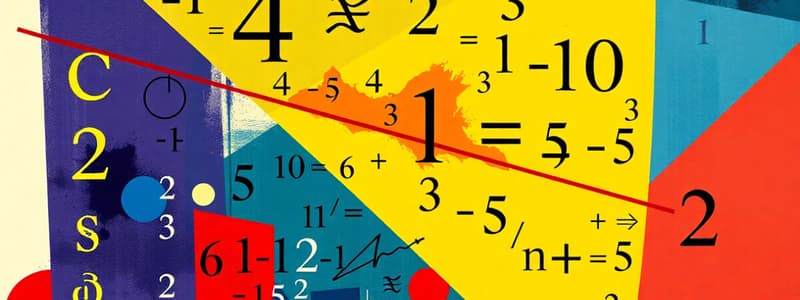Podcast
Questions and Answers
Which number system encompasses both rational and irrational numbers?
Which number system encompasses both rational and irrational numbers?
- Natural numbers
- Real numbers (correct)
- Integers
- Complex numbers
A student is trying to determine the area of a complex shape by dividing it into infinitely small rectangles and summing their areas. Which branch of mathematics is the student primarily using?
A student is trying to determine the area of a complex shape by dividing it into infinitely small rectangles and summing their areas. Which branch of mathematics is the student primarily using?
- Integral calculus (correct)
- Algebra
- Differential calculus
- Trigonometry
If $a = 3$ and $b = -2$, which branch of mathematics is primarily used to solve the equation $5a + 3b = x$ for $x$?
If $a = 3$ and $b = -2$, which branch of mathematics is primarily used to solve the equation $5a + 3b = x$ for $x$?
- Calculus
- Statistics
- Arithmetic
- Elementary algebra (correct)
An engineer uses sine, cosine, and tangent to calculate the height of a building using angles of elevation and distance. Which branch of mathematics is the engineer applying?
An engineer uses sine, cosine, and tangent to calculate the height of a building using angles of elevation and distance. Which branch of mathematics is the engineer applying?
Which mathematical concept is essential for understanding both instantaneous rates of change and the area under a curve?
Which mathematical concept is essential for understanding both instantaneous rates of change and the area under a curve?
A computer scientist designs logic gates using AND, OR, and NOT operations. Which branch of mathematics is most relevant to this task?
A computer scientist designs logic gates using AND, OR, and NOT operations. Which branch of mathematics is most relevant to this task?
Which of the following measures is most useful for describing the spread of a dataset?
Which of the following measures is most useful for describing the spread of a dataset?
When solving for the dimensions of a rectangle inscribed within a circle, which mathematical fields are most likely to be combined?
When solving for the dimensions of a rectangle inscribed within a circle, which mathematical fields are most likely to be combined?
A researcher collects survey responses to predict election outcomes. Which branch of mathematics is being applied?
A researcher collects survey responses to predict election outcomes. Which branch of mathematics is being applied?
Which of the following is an example of using differential calculus?
Which of the following is an example of using differential calculus?
Flashcards
What is Mathematics?
What is Mathematics?
The study of quantity, structure, space, and change.
What is Arithmetic?
What is Arithmetic?
Basic operations on numbers, including addition, subtraction, multiplication, and division.
What are Rational Numbers?
What are Rational Numbers?
Numbers that can be written as a fraction a/b, where a and b are integers and b ≠ 0.
What is Algebra?
What is Algebra?
Signup and view all the flashcards
What are Linear Equations?
What are Linear Equations?
Signup and view all the flashcards
What is Geometry?
What is Geometry?
Signup and view all the flashcards
What is Analytic Geometry?
What is Analytic Geometry?
Signup and view all the flashcards
What is Calculus?
What is Calculus?
Signup and view all the flashcards
What is Differential Calculus?
What is Differential Calculus?
Signup and view all the flashcards
What is Trigonometry?
What is Trigonometry?
Signup and view all the flashcards
Study Notes
- Math is the science and study of quantity, structure, space, and change
- Mathematicians seek out patterns, formulate new conjectures, and establish truth by rigorous deduction from appropriately chosen axioms and definitions
Arithmetic
- Arithmetic is the oldest and most elementary branch of mathematics
- It deals with basic operations on numbers: addition, subtraction, multiplication, and division
- The natural numbers (1, 2, 3, ...) form the basis of arithmetic
- Integers include natural numbers, zero, and negative numbers
- Rational numbers are numbers that can be expressed as a fraction a/b, where a and b are integers and b ≠ 0
- Real numbers include all rational numbers and irrational numbers (numbers that cannot be expressed as a fraction, like √2 or π)
- Complex numbers extend real numbers by including the imaginary unit i, defined as the square root of -1
Algebra
- Algebra is a branch of mathematics that generalizes arithmetic, using variables to represent numbers and express relationships
- Elementary algebra involves solving equations and inequalities with these variables
- Linear equations are algebraic equations where the highest power of the variable is 1
- Quadratic equations are algebraic equations where the highest power of the variable is 2
- Abstract algebra studies algebraic structures such as groups, rings, and fields
- Boolean algebra deals with logical operations and is fundamental to computer science
Geometry
- Geometry is concerned with the properties and relations of points, lines, surfaces, solids, and higher dimensional analogs
- Euclidean geometry is based on a set of axioms defined by Euclid, including concepts like points, lines, angles, and shapes
- Analytic geometry uses algebra to describe geometric shapes using a coordinate system
- Trigonometry studies the relationships between the angles and sides of triangles
- Differential geometry uses calculus to study the properties of curves and surfaces
Calculus
- Calculus is the study of continuous change
- Differential calculus deals with the rate of change of a function (its derivative)
- Integral calculus is concerned with the accumulation of quantities (its integral) and the areas under or between curves
- The fundamental theorem of calculus connects differentiation and integration
- Limits and continuity are foundational concepts for calculus
Trigonometry
- Trigonometry is the branch of mathematics that studies relationships between angles and sides of triangles
- Sine, cosine, and tangent are fundamental trigonometric functions, relating angles to ratios of sides in a right triangle
- Trigonometric identities are equations involving trigonometric functions that are true for all values of the variables involved
- The Law of Sines and Law of Cosines are used to solve triangles (find unknown angles and sides)
Statistics and Probability
- Statistics involves the collection, analysis, interpretation, presentation, and organization of data
- Descriptive statistics summarize and describe the characteristics of a data set using measures like mean, median, mode, and standard deviation
- Inferential statistics uses sample data to make inferences and predictions about a larger population
- Probability is the measure of the likelihood that an event will occur
- Probability theory provides the framework for analyzing random events
- Common probability distributions include the normal distribution, binomial distribution, and Poisson distribution
Studying That Suits You
Use AI to generate personalized quizzes and flashcards to suit your learning preferences.




